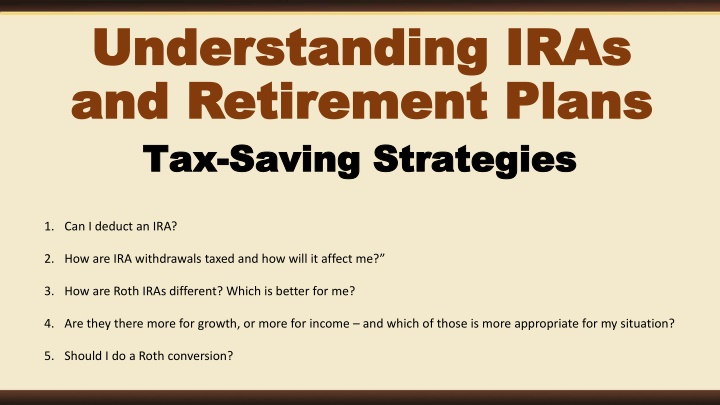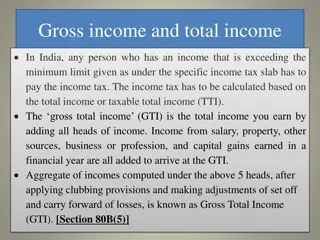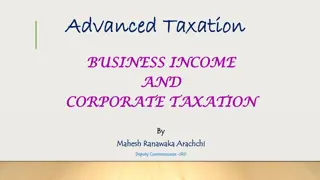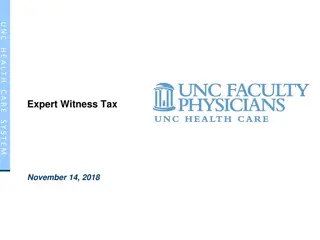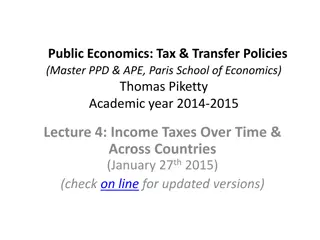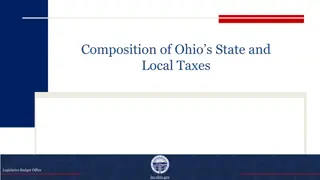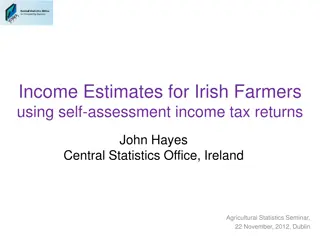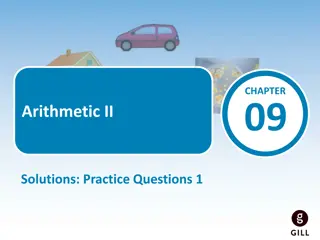Post Graduate Diploma in Business & Finance: Income Tax Rates and Tax Credits
Explore the income tax rates for individuals, specific tax credits, special tax rates for different industries, and examples of calculating tax liabilities. Learn about tax credits including double taxation reliefs and more.
Download Presentation

Please find below an Image/Link to download the presentation.
The content on the website is provided AS IS for your information and personal use only. It may not be sold, licensed, or shared on other websites without obtaining consent from the author.If you encounter any issues during the download, it is possible that the publisher has removed the file from their server.
You are allowed to download the files provided on this website for personal or commercial use, subject to the condition that they are used lawfully. All files are the property of their respective owners.
The content on the website is provided AS IS for your information and personal use only. It may not be sold, licensed, or shared on other websites without obtaining consent from the author.
E N D
Presentation Transcript
Understanding IRAs Understanding IRAs and Retirement Plans and Retirement Plans Tax Tax- -Saving Strategies Saving Strategies 1. Can I deduct an IRA? 2. How are IRA withdrawals taxed and how will it affect me? 3. How are Roth IRAs different? Which is better for me? 4. Are they there more for growth, or more for income and which of those is more appropriate for my situation? 5. Should I do a Roth conversion?
History of IRAs: Employee Retirement Income Security Act of 1974 (ERISA): Federal law establishing standards for private pension plans. Did not require employers to have pension plans, but enforces rules for those that do. Studebaker went out of business in the late 60s and couldn t pay their employee pensions because they weren t funded adequately. Taxpayers could contribute up to $1,500 per year and reduce taxable income by the amount of the contributions. Economic Recovery Tax Act 1981 (ERTA): Under ERISA, IRAs were restricted to those workers who were not already covered by a qualified employment-based retirement plan. Under ERTA, all taxpayers who were age 70 or younger could contribute to an IRA. However, because of the SECURE 2.0 Act, now there is no age limit. Taxpayers could contribute up to $2,000 to their own IRA and $250 for a nonworking spouse and receive a tax deduction. These provisions have been amended over the years since their inception and are now very different.
Tax Deferrals for Retirees: This example uses the assumption that we are putting $2,000 per year in an IRA for 40 years with an assumed 30% tax bracket. Example of Tax-Deferred Contribution and Interest/Gains: You put $2,000 per year in an IRA for 40 years at 8% tax deferred. After 40 years, you would have $559,562 x .04 (Cash-Flow Rule) = $22,382 Example of Taxable Contributions and 8% Return: You put $2,000 per year (which is $1,400 after taxes) in an IRA for 40 years at 8% taxable return. After 40 years, you would have $207,032 x .04 (Cash-Flow Rule) = $8,281
Types of IRAs: Traditional IRAs: Contributions may be tax deductible. Savings grow tax-deferred while inside the account. Withdrawals are generally added to your income. Withdrawals made prior to 59 may be subject to an additional 10% early withdrawal penalty. Roth IRAs after Tax Contributions: Savings grow tax-deferred while inside the account. Contributions may be withdrawn tax-free after meeting the following conditions: 1. Withdrawals must be taken after a 5-year holding period 2. Withdrawals must be taken after age 59 3. First home purchase and college expenses are NOT subject to early withdrawal penalty Qualified distributionsmay include earnings and are also tax-free. SEP and Simple IRAs: For businesses and self-employed individuals. Source: https://www.schwab.com/ira/roth-ira/withdrawal-rules
2023 IRA Contribution and Income Limits: Due to the SECURE 2.0 Act, if you have earned income there are no longer age limits to contributing to a traditional IRA While the age limit for making traditional IRA contributions is eliminated, earned income is still required to make a regular or spousal IRA contribution Source: https://waysandmeans.house.gov/sites/democrats.waysandmeans.house.gov/files/documents/SECURE%20Act%20section%20by%20section.pdf
2023 IRA Deduction Limits, Covered by a Retirement Plan at Work: If Your Filing Status Is... And Your Modified AGI Is... Then You Can Take... a full deduction up to the amount of your contribution limit. $73,000 or less more than $73,000 but less than $83,000 singleor head of household a partial deduction. $83,000 or more no deduction. a full deduction up to the amount of your contribution limit. $116,000 or less married filing jointlyor qualifying widow(er) more than $116,000 but less than $136,000 $136,000 or more a partial deduction. no deduction. less than $10,000 a partial deduction. married filing separately $10,000 or more no deduction Source: https://www.irs.gov/retirement-plans/2021-ira-deduction-limits-effect-of-modified-agi-on-deduction-if- you-are-covered-by-a-retirement-plan-at-work
2022 IRA Deduction Limits, Not Covered by a Retirement Plan at Work: If Your Filing Status Is... And Your Modified AGI Is... Then You Can Take... single, head of household,or qualifying widow(er) a full deduction up to the amount of your contribution limit. any amount married filing jointlyor separatelywith a spouse whois notcovered by a plan at work a full deduction up to the amount of your contribution limit. any amount a full deduction up to the amount of your contribution limit. $218,000 or less married filing jointlywith a spouse whois covered by a plan at work more than $218,000 but less than $228,000 a partial deduction. no deduction. $228,000 or more less than $10,000 a partial deduction. married filing separatelywith a spouse whois covered by a plan at work no deduction. $10,000 or more If you file separately and did not live with your spouse at any time during the year, your IRA deduction is determined under the "Single" filing status. Source: https://www.irs.gov/retirement-plans/2021-ira-deduction-limits-effect-of-modified-agi-on-deduction-if-you- are-not-covered-by-a-retirement-plan-at-work
2023 Tax Brackets and Rates: Withdrawals from retirement accounts are generally taxed at ordinary income tax rates. Withdrawals are added to your income and taxed at whatever bracket you re in. Rate Single Filers Married Joint Filers Head of Household Filers 10% Up to $11,000 Up to $22,000 Up to $15,700 12% $11,000 to $44,725 $22,000 to $89,450 $15,700 to $59,850 22% $44,725 to $95,375 $89,450 to $190,750 $59,850 to $95,350 24% $95,375 to $182,100 $190,750 to $364,200 $95,350 to $182,100 32% $182,100 to $231,250 $364,200 to $462,500 $182,100 to $231,250 35% $231,250 to $578,125 $462,500 to $693,750 $231,250 to $578,100 37% $578,125 or more $693,750 or more $578,100 or more https://taxfoundation.org/2023-tax-brackets/
SOCIAL SECURITY TAXATION OF SOCIAL SECURITY BENEFITS AMOUNT OF SS SUBJECT TO TAX FILING STATUS PROVISIONAL INCOME* Under $32,000 $32,000 - $44,000 Over $44,000 0 Married filing jointly Up to 50% Up to 85% Under $25,000 $25,000 - $34,000 Over $34,000 0 Single, head of household, qualifying widow(er), married filing separately and living apart from spouse Up to 50% Up to 85% Married filing separately and living with spouse Over 0 85% *Provisional income = AGI + one-half of SS benefit + tax-exempt interest 9
Why do Required Minimum Distributions (RMDs) exist? The government wants you to save for retirement and gives you incentives to do it (pre-tax contributions and tax-deferred interest growth). Butthe IRS still wants its cut after you ve retired! Thus, Required Minimum Distributions The annual amount that must be withdrawn from a traditional IRA or qualified retirement plan after the account holder reaches a certain age.
Changes to your RMDs: The SECURE Act 2.0 The SECURE Act 2.0, which stands for Setting Every Community Up for Retirement Enhancement , was signed into law in 2022. The RMD age is now 73 and will increase to 75 in 2033. The penalty for not paying your RMDs was reduced from 50% to 25% (IRA owners who submit a corrected tax return can have the penalty reduced to 10%). Beginning January 1, 2025, the catch-up contribution limit will be raised to $10,000 and will be indexed to inflation. Beginning January 1, 2024, the IRA limit will be indexed to inflation and can potentially increase every year based on federal COLAs. Employers will be able to provide the option of vested contributions to Roth IRAs. However, RMDs are still required for Roth accounts until the 2024 tax year.
When to take RMDs: Age 73 Exception: If you are still working at age 73 and participating in a retirement plan at a business you do not own, you do not have to take any RMD from that plan until the year you retire. There is no such exception for IRAs. There are now penalty-free withdrawals for birth or adoption
How much will your RMDs be? Use the formula: Balance of your account on Dec. 31 of the preceding year Your IRS-assumed life expectancy (LE)(Pub 590) = Your RMD Example: $158,225 IRA 26.5-year LE (age 73) = $5,970 RMD* Uniform Lifetime Table formula decreases by less than 1 year for each year you age. It is recalculated annually in decimals (age-72: LE-27.4, age-73: LE-26.5, age-74: LE-25.5, etc.). This formula applies to unmarried IRA owners and owners whose spouses are not more than 10 years younger. *Source: Investopedia.com
Roth IRA Contribution and Income Limits: And your modified AGI is... If your filing status is... Then you can contribute... < $218,000 up to the limit married filing jointly or qualifying widow(er) > $218,000 but < $228,000 a reduced amount > $228,000 zero married filing separately and you lived with your spouse at any time during the year < $10,000 a reduced amount > $10,000 zero < $138,000 up to the limit single, head of household, or married filing separately and you did not live with your spouse at any time during the year > $138,000 but < $153,000 a reduced amount > $153,000 zero Source: https://www.irs.gov/retirement-plans/amount-of-roth-ira-contributions-that-you-can-make-for-2023
2023 Roth IRA Contribution and Limits: Maximum contribution is $6,500 If age 50 or older, contribution is $7,500 Must have compensation, such as: Earned income Taxable alimony No age limit Source: https://www.irs.gov/retirement-plans/plan-participant-employee/retirement-topics-ira-contribution- limits#:~:text=For%202023%2C%20the%20total%20contributions,taxable%20compensation%20for%20the%20year
Employer-Sponsored Retirement Plans: If you are still working, check to see what employer-sponsored retirement plans are offered. The 2023 salary limit on employee elective deferrals is $22,500 for 401(k) plans The 2023 limit on employee elective deferrals to a SIMPLE 401(k) plan is $15,500 If you re 50 or older, you can make catch-up contributions $7,500 to traditional 401(k) plans $3,500 to SIMPLE 401(k) plans You can contribute money to an employer-sponsored retirement plan and an IRA/Roth IRA. Employer liability protection .now included for annuities in plans Source: https://www.irs.gov/retirement-plans/retirement-plans-for-self-employed-people
Are you earning enough dividends and interest to help satisfy your Income/RMDs?
TR Total Return= I Income+ G Growth (Capital Growth/Loss) (Interest/Dividends)
4% Cash Flow Rule Said: 4% Cash Flow Rule Said: You can rely on the G You can rely on the G With $1,000,000, you should be able to withdraw $40,000/year for life. But what if you retired in 2000 and relied on the G ?
Market History The The Withdrawal Withdrawal Method Method DATE BEG. CASH S&P 500 Total Return END CASH WITHDRAWAL $871,496 1/2000 $1,000,000 -9.10% 40,000 $871,496 1/2001 -11.89% 40,000 $728,734 1/2002 $728,734 -22.10% 40,000 $531,372 1/2003 $531,372 28.68% 40,000 $637,080 1/2004 $637,080 10.88% 40,000 $663,272 1/2005 $663,272 4.91% 40,000 $654,123 1/2006 $654,123 15.79% 40,000 $713,949 1/2007 $713,949 5.49% 40,000 $713,041 1/2008 $713,041 -37.00% 40,000 $418,385 1/2009 $418,385 26.46% 40,000 $480,779 1/2010 $480,779 15.06% 40,000 $508,140 1/2011 $508,140 2.11% 40,000 $479,099 1/2012 $479,099 16.00% 40,000 $514,132 *Returns calculated using month end price of the SPTR index published by CBOE
Market History The Income The Income Method: Method: Spending the dividend only DATE BEG. CASH END CASH S&P 500 Total Return 1.5% DIVIDEND $894,909 1/2000 $1,000,000 -9.10% 15,000 $894,909 1/2001 -11.89% 15,000 $773,850 1/2002 $773,850 -22.10% 15,000 $589,209 1/2003 $589,209 28.68% 15,000 $740,704 1/2004 $740,704 10.88% 15,000 $805,132 1/2005 $805,132 4.91% 15,000 $829,031 1/2006 $829,031 15.79% 15,000 $943,663 1/2007 $943,663 5.49% 15,000 $980,458 1/2008 $980,458 -37.00% 15,000 $606,142 1/2009 $606,142 26.46% 15,000 $748,431 1/2010 $748,431 15.06% 15,000 $844,273 1/2011 $844,273 2.11% 15,000 $847,187 1/2012 $847,187 16.00% 15,000 $967,152 *Please note: The 1.5% dividend return listed is not the actual S&P 500 dividend yield. This number is based on a hypothetical return of 1.5%.
Hypothetical Market History The Income The Income Method: Method: Spending the dividend only DATE BEG. CASH ** END CASH S&P 500 Total Return *Hypothetical 4.0% DIVIDEND $894,909 1/2000 $1,000,000 -9.10% 40,000 $894,909 1/2001 -11.89% 40,000 $773,850 1/2002 $773,850 -22.10% 40,000 $589,209 1/2003 $589,209 28.68% 40,000 $740,704 1/2004 $740,704 10.88% 40,000 $805,132 1/2005 $805,132 4.91% 40,000 $829,031 1/2006 $829,031 15.79% 40,000 $943,663 1/2007 $943,663 5.49% 40,000 $980,458 1/2008 $980,458 -37.00% 40,000 $606,142 1/2009 $606,142 26.46% 40,000 $748,431 1/2010 $748,431 15.06% 40,000 $844,273 1/2011 $844,273 2.11% 40,000 $847,187 1/2012 $847,187 16.00% 40,000 $967,152 * The 4.0% dividend yield listed is not the actual S&P 500 dividend yield. ** This number is based on a hypothetical dividend of 4.0%.
Roth IRA Conversions: Special transaction where IRA (or other pre-tax retirement funds) are moved to a Roth IRA. Taxable amount converted is added to your income. Example: Jill converts $100,000 from her IRA to a Roth IRA: Jill will have to add $100,000 to her income. The conversion income will be taxed at Jill s tax bracket. Consult your tax professional.
Who Can Do a Roth IRA Conversion? Anyone can convert their IRA (or other eligible retirement account) to a Roth IRA. No age limits (high or low). No income limits (high or low). No requirement to be working.
Risk of Rising Tax Rates: Roth conversions may provide a hedge against an increase in future tax rates. Future tax rates are unknown. Taxes are a major concern for many retirees. Roth conversions allow you to pay taxes at today s tax rates. If you believe your future tax rate will be higher, a Roth conversion may benefit you. Can help manage other costs tied to your income: Social Security benefits included in income. Medicare Part B premiums.
Roth IRA Conversion Strategy: Before Conversion 12% 10% 37% 35% 32% 22% 24% Roth Conversion Income After Conversion 10% 12% 32% 22% 24% 37% 35%
Risks of Roth IRA Conversions: There is no guarantee that the Roth IRA distribution rules won t be changed in the future. A Roth IRA conversion may also trigger other unintended taxes. There is no guarantee that investments will appreciate in the Roth account after a conversion.
Still Have Questions On: How can I help avoid a 10% penalty for early withdrawals from an IRA? Can I make a deductible IRA or Roth IRA contribution? How can I help avoid a 25% IRS tax penalty? How can I help reduce the risks of rising tax rates? What are the benefits and risks of Roth IRA conversions?
Thank You! Investment Advisory Services offered through Sound Income Strategies, LLC, an SEC Registered Investment Advisory Firm.
